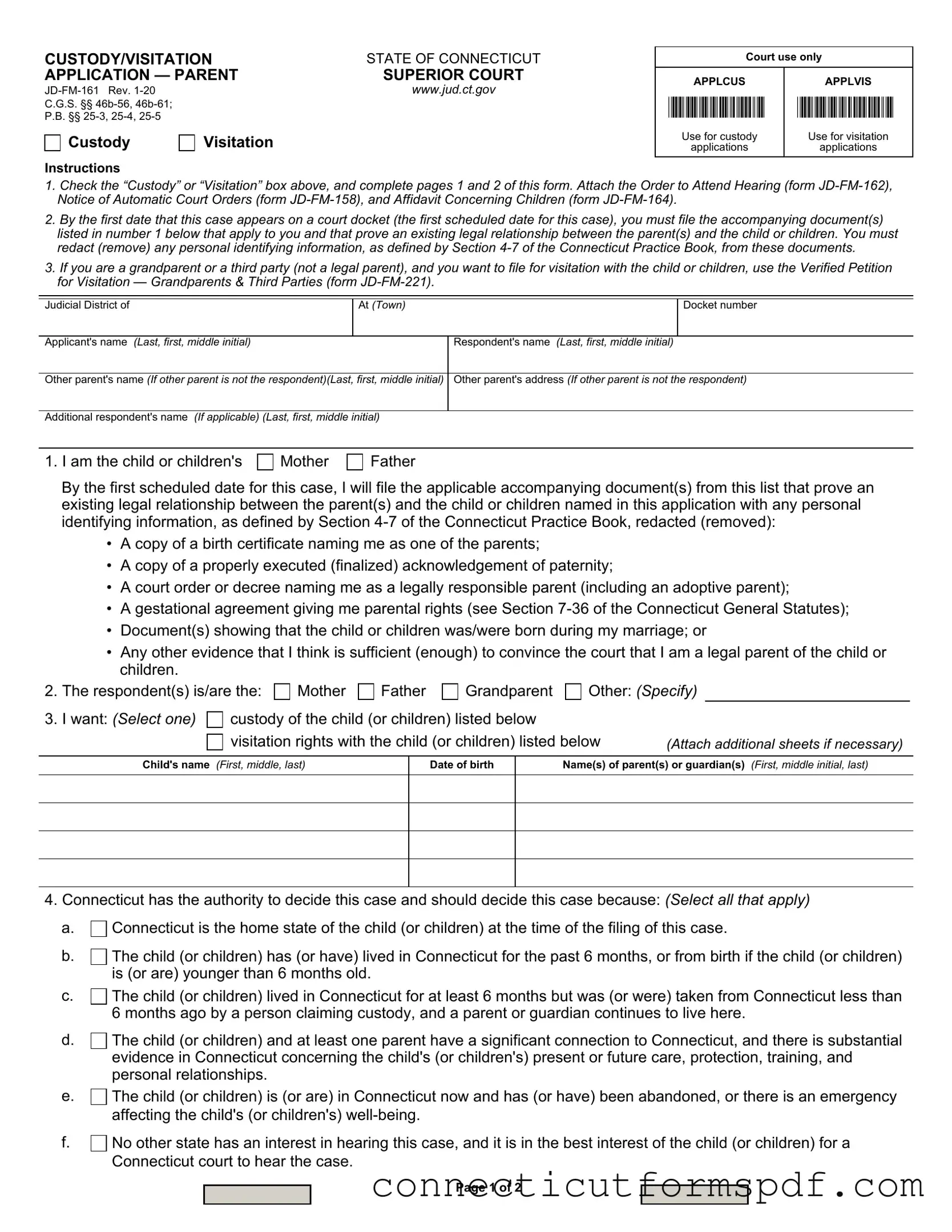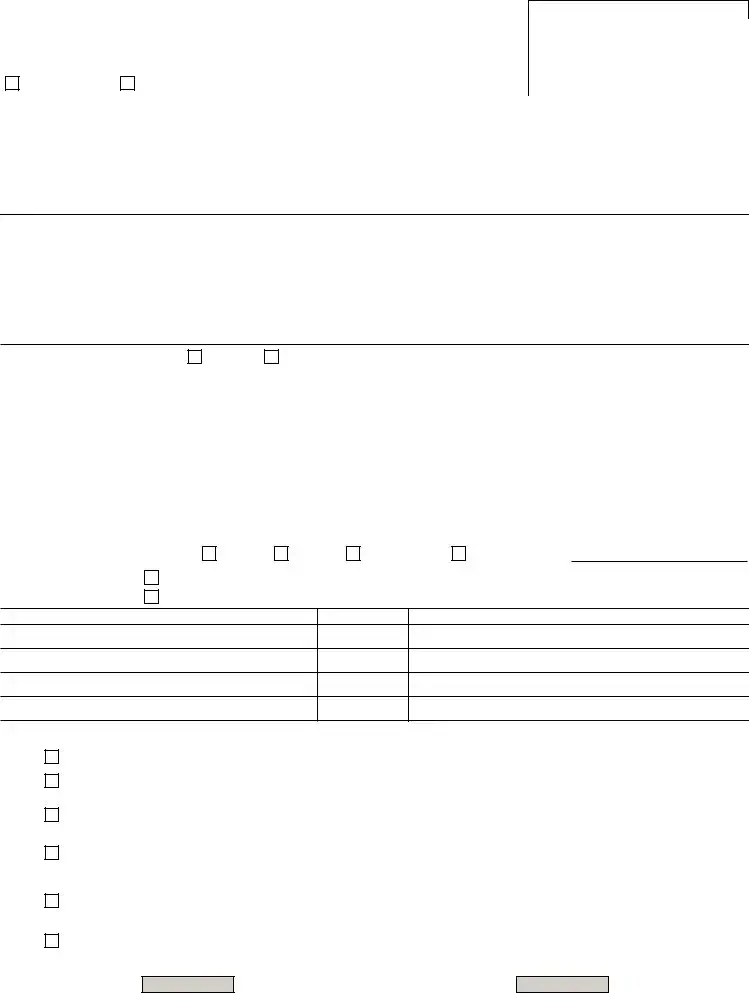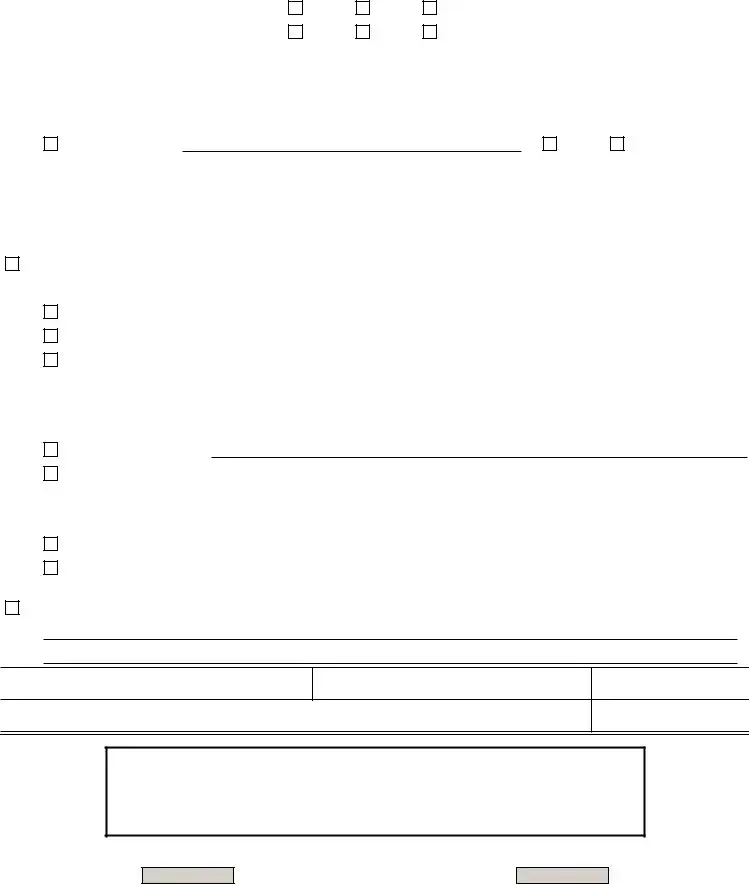CUSTODY/VISITATION |
STATE OF CONNECTICUT |
APPLICATION — PARENT |
SUPERIOR COURT |
JD-FM-161 Rev. 1-20 |
|
www.jud.ct.gov |
C.G.S. §§ 46b-56, 46b-61; |
|
|
P.B. §§ 25-3, 25-4, 25-5 |
|
|
Custody |
Visitation |
|
Instructions
Court use only
APPLCUS |
APPLVIS |
*APPLCUS* |
*APPLVIS* |
Use for custody |
Use for visitation |
applications |
applications |
|
|
1.Check the “Custody” or “Visitation” box above, and complete pages 1 and 2 of this form. Attach the Order to Attend Hearing (form JD-FM-162), Notice of Automatic Court Orders (form JD-FM-158), and Affidavit Concerning Children (form JD-FM-164).
2.By the first date that this case appears on a court docket (the first scheduled date for this case), you must file the accompanying document(s) listed in number 1 below that apply to you and that prove an existing legal relationship between the parent(s) and the child or children. You must redact (remove) any personal identifying information, as defined by Section 4-7 of the Connecticut Practice Book, from these documents.
3.If you are a grandparent or a third party (not a legal parent), and you want to file for visitation with the child or children, use the Verified Petition for Visitation — Grandparents & Third Parties (form JD-FM-221).
Judicial District of |
|
At (Town) |
|
Docket number |
|
|
|
|
Applicant's name (Last, first, middle initial) |
Respondent's name (Last, first, middle initial) |
|
|
Other parent's name (If other parent is not the respondent)(Last, first, middle initial) |
Other parent's address (If other parent is not the respondent) |
|
|
|
|
Additional respondent's name |
(If applicable) (Last, first, middle initial) |
|
|
1. I am the child or children's
By the first scheduled date for this case, I will file the applicable accompanying document(s) from this list that prove an existing legal relationship between the parent(s) and the child or children named in this application with any personal identifying information, as defined by Section 4-7 of the Connecticut Practice Book, redacted (removed):
•A copy of a birth certificate naming me as one of the parents;
•A copy of a properly executed (finalized) acknowledgement of paternity;
•A court order or decree naming me as a legally responsible parent (including an adoptive parent);
•A gestational agreement giving me parental rights (see Section 7-36 of the Connecticut General Statutes);
•Document(s) showing that the child or children was/were born during my marriage; or
•Any other evidence that I think is sufficient (enough) to convince the court that I am a legal parent of the child or children.
2. The respondent(s) is/are the:
custody of the child (or children) listed below |
|
visitation rights with the child (or children) listed below |
(Attach additional sheets if necessary) |
Child's name (First, middle, last)
Name(s) of parent(s) or guardian(s) (First, middle initial, last)
4. Connecticut has the authority to decide this case and should decide this case because: (Select all that apply)
Connecticut is the home state of the child (or children) at the time of the filing of this case.
The child (or children) has (or have) lived in Connecticut for the past 6 months, or from birth if the child (or children) is (or are) younger than 6 months old.
The child (or children) lived in Connecticut for at least 6 months but was (or were) taken from Connecticut less than 6 months ago by a person claiming custody, and a parent or guardian continues to live here.
The child (or children) and at least one parent have a significant connection to Connecticut, and there is substantial evidence in Connecticut concerning the child's (or children's) present or future care, protection, training, and personal relationships.
The child (or children) is (or are) in Connecticut now and has (or have) been abandoned, or there is an emergency affecting the child's (or children's) well-being.
No other state has an interest in hearing this case, and it is in the best interest of the child (or children) for a Connecticut court to hear the case.
Page 1 of 2
Additional Instructions:
•If you are the mother or father and want custody, go to Number 5 below, and continue from there.
•If you are the mother or father and want visitation, go to the Claim For Relief section below, and continue from there.
5.The applicant, respondent, or any child (or children) listed has (or have) received financial support and/or HUSKY from the State of Connecticut:
Financial Support: (Select one)
HUSKY Health Insurance: (Select one)
If you checked yes for Financial Support and/or HUSKY, send a copy of this Application, Order to Attend Hearing, Notice of Automatic Court Orders, and any other document filed with this application to the Office of the Attorney General, 165 Capitol Avenue, Hartford, CT 06106, and file the Certification of Notice (form JD-FM-175) with the court clerk.
6.The applicant, respondent, or any child (or children) listed has (or have) received financial support from a city or town in Connecticut: (Select one)
If you checked yes, send a copy of this Application, Order to Attend Hearing, Notice of Automatic Court Orders, and any other document filed with this application to the City or Town Clerk of the city or town providing assistance, and file the Certification of Notice (form JD-FM-175) with the court clerk.
Claim for Relief
For Custody: (The Applicant asks the Court for custody orders) (Select all that apply)
Regarding decision-making responsibility:
Sole legal custody
Joint legal custody
A parenting responsibility plan, which includes a plan for the parental decision-making regarding the minor child (or
children)
And
Regarding physical custody:
Primary residence with:
A parental physical access schedule and/or visitation
Regarding child support: (If custody application — includes cash medical, health insurance, unreimbursed medical expenses, and qualifying child care)
Child Support
An order for the educational support of my child (or children) for post-high school education or training under Section 46b-56c of the Connecticut General Statutes.
For Visitation: (The Applicant asks the Court for visitation orders as follows)
Signature of Applicant or Petitioner
Print name of person signing at left
Telephone (Area code first)
ADA NOTICE
The Judicial Branch of the State of Connecticut complies with the Americans with Disabilities Act (ADA). If you need a reasonable accommodation in accordance with the ADA, contact a court clerk or an ADA contact person listed at www.jud.ct.gov/ADA.


